Identifying Tech Integration Challenges in Retail: M&S Case Study
VerifiedAdded on 2020/12/30
|12
|3057
|256
Report
AI Summary
This research project investigates the challenges of integrating emerging technology within the retail sector, using Marks and Spencer (M&S) as a case study. The introduction outlines the study's title, background, rationale, aims, and objectives, which include evaluating the concept of integrating emerging technologies, identifying factors involved, assessing challenging issues, and recommending solutions. The literature review explores the concept of integrating technology, factors like Facebook and Instagram, and challenges such as the risk of data breaches and the need for employee training. The methodology section details the research philosophy (interpretivism), approach (inductive), data collection methods (primary and secondary), sampling (purposive with 20 IT personnel), data analysis (qualitative), and ethical considerations. The study aims to provide insights into the difficulties faced by retailers like M&S in adopting new technologies and offers recommendations for overcoming these challenges to improve business outcomes. The report emphasizes the importance of understanding the impact of technology on customer experience, operational efficiency, and overall business performance.
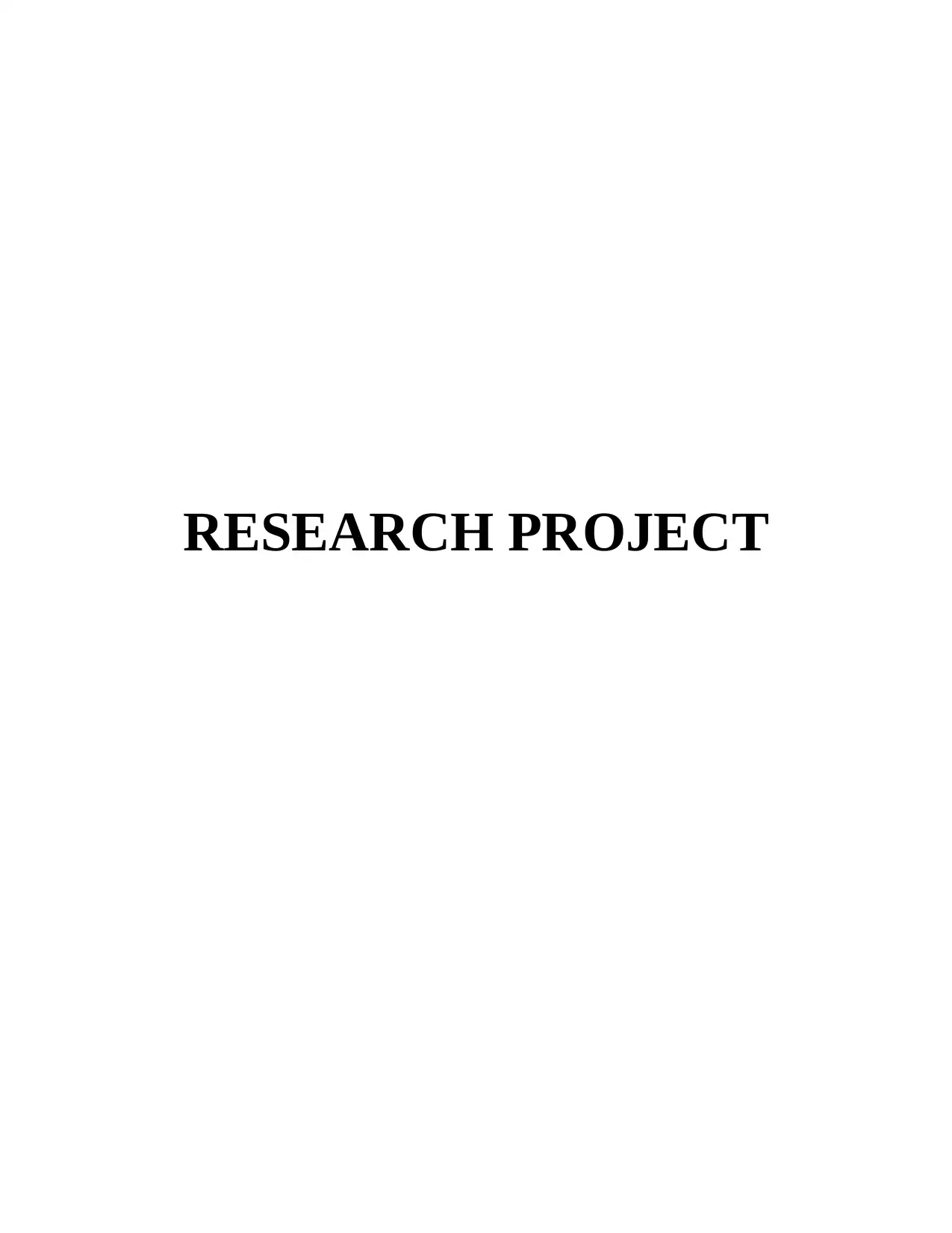
RESEARCH PROJECT
Paraphrase This Document
Need a fresh take? Get an instant paraphrase of this document with our AI Paraphraser
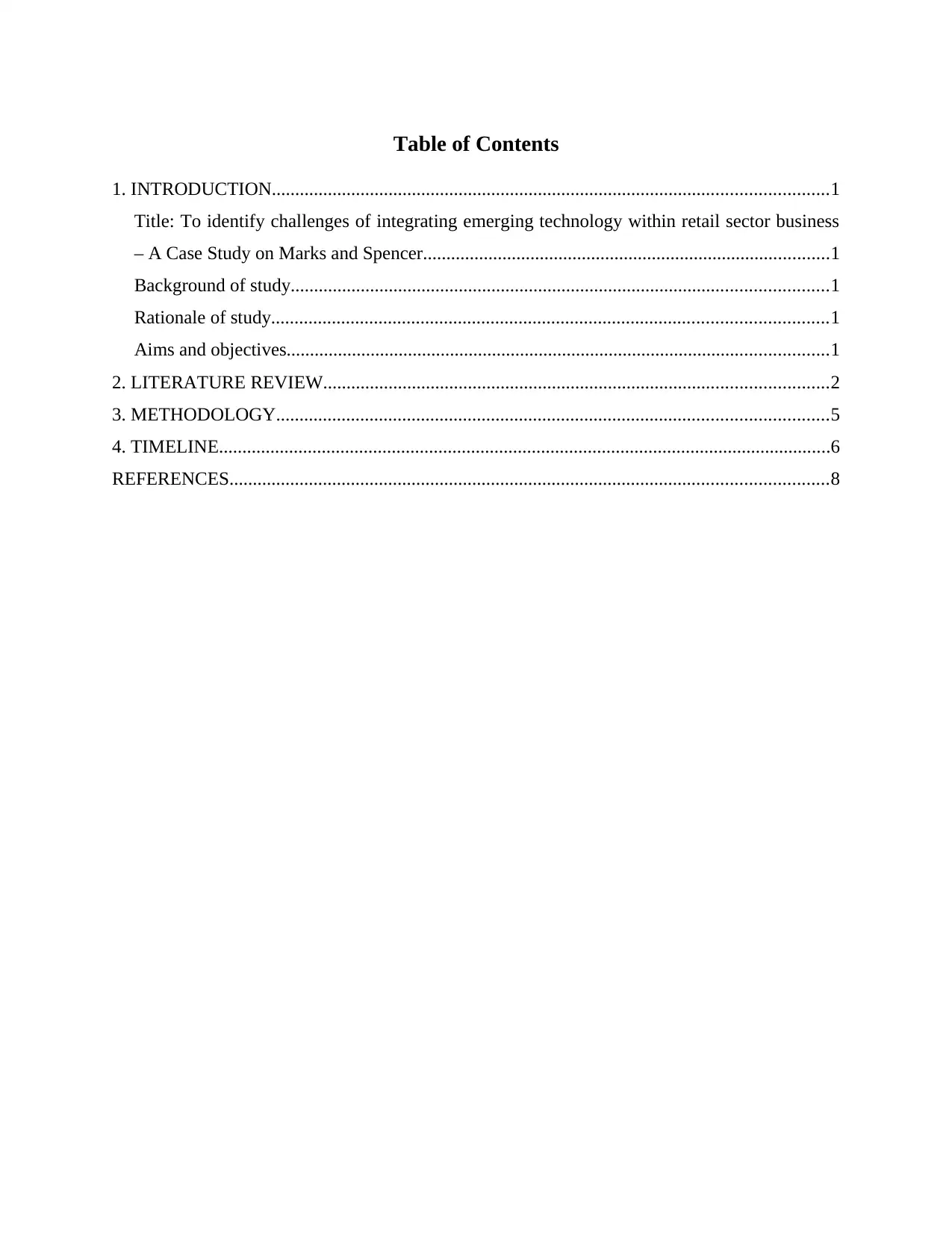
Table of Contents
1. INTRODUCTION.......................................................................................................................1
Title: To identify challenges of integrating emerging technology within retail sector business
– A Case Study on Marks and Spencer.......................................................................................1
Background of study...................................................................................................................1
Rationale of study.......................................................................................................................1
Aims and objectives....................................................................................................................1
2. LITERATURE REVIEW............................................................................................................2
3. METHODOLOGY......................................................................................................................5
4. TIMELINE...................................................................................................................................6
REFERENCES................................................................................................................................8
1. INTRODUCTION.......................................................................................................................1
Title: To identify challenges of integrating emerging technology within retail sector business
– A Case Study on Marks and Spencer.......................................................................................1
Background of study...................................................................................................................1
Rationale of study.......................................................................................................................1
Aims and objectives....................................................................................................................1
2. LITERATURE REVIEW............................................................................................................2
3. METHODOLOGY......................................................................................................................5
4. TIMELINE...................................................................................................................................6
REFERENCES................................................................................................................................8

⊘ This is a preview!⊘
Do you want full access?
Subscribe today to unlock all pages.

Trusted by 1+ million students worldwide
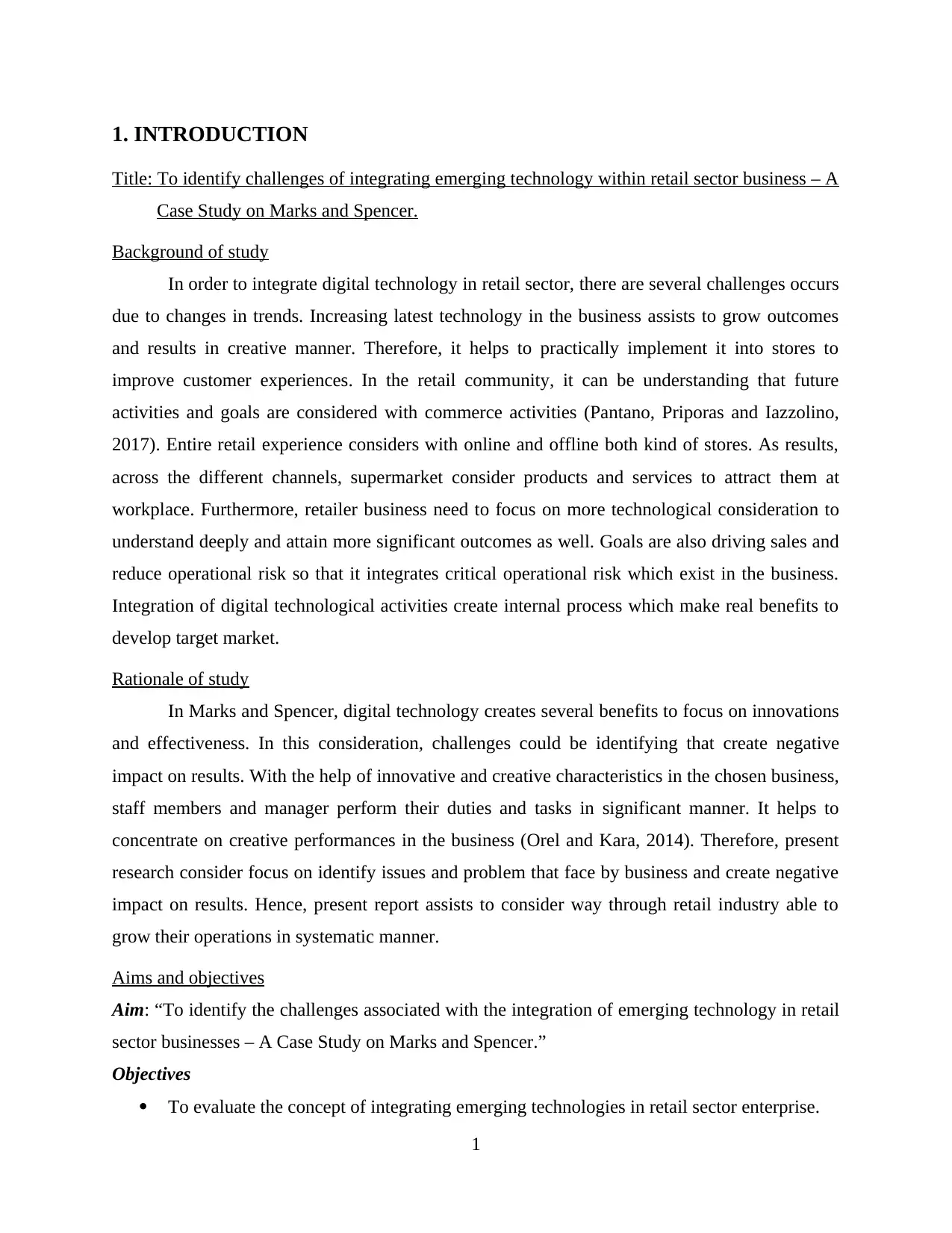
1. INTRODUCTION
Title: To identify challenges of integrating emerging technology within retail sector business – A
Case Study on Marks and Spencer.
Background of study
In order to integrate digital technology in retail sector, there are several challenges occurs
due to changes in trends. Increasing latest technology in the business assists to grow outcomes
and results in creative manner. Therefore, it helps to practically implement it into stores to
improve customer experiences. In the retail community, it can be understanding that future
activities and goals are considered with commerce activities (Pantano, Priporas and Iazzolino,
2017). Entire retail experience considers with online and offline both kind of stores. As results,
across the different channels, supermarket consider products and services to attract them at
workplace. Furthermore, retailer business need to focus on more technological consideration to
understand deeply and attain more significant outcomes as well. Goals are also driving sales and
reduce operational risk so that it integrates critical operational risk which exist in the business.
Integration of digital technological activities create internal process which make real benefits to
develop target market.
Rationale of study
In Marks and Spencer, digital technology creates several benefits to focus on innovations
and effectiveness. In this consideration, challenges could be identifying that create negative
impact on results. With the help of innovative and creative characteristics in the chosen business,
staff members and manager perform their duties and tasks in significant manner. It helps to
concentrate on creative performances in the business (Orel and Kara, 2014). Therefore, present
research consider focus on identify issues and problem that face by business and create negative
impact on results. Hence, present report assists to consider way through retail industry able to
grow their operations in systematic manner.
Aims and objectives
Aim: “To identify the challenges associated with the integration of emerging technology in retail
sector businesses – A Case Study on Marks and Spencer.”
Objectives
To evaluate the concept of integrating emerging technologies in retail sector enterprise.
1
Title: To identify challenges of integrating emerging technology within retail sector business – A
Case Study on Marks and Spencer.
Background of study
In order to integrate digital technology in retail sector, there are several challenges occurs
due to changes in trends. Increasing latest technology in the business assists to grow outcomes
and results in creative manner. Therefore, it helps to practically implement it into stores to
improve customer experiences. In the retail community, it can be understanding that future
activities and goals are considered with commerce activities (Pantano, Priporas and Iazzolino,
2017). Entire retail experience considers with online and offline both kind of stores. As results,
across the different channels, supermarket consider products and services to attract them at
workplace. Furthermore, retailer business need to focus on more technological consideration to
understand deeply and attain more significant outcomes as well. Goals are also driving sales and
reduce operational risk so that it integrates critical operational risk which exist in the business.
Integration of digital technological activities create internal process which make real benefits to
develop target market.
Rationale of study
In Marks and Spencer, digital technology creates several benefits to focus on innovations
and effectiveness. In this consideration, challenges could be identifying that create negative
impact on results. With the help of innovative and creative characteristics in the chosen business,
staff members and manager perform their duties and tasks in significant manner. It helps to
concentrate on creative performances in the business (Orel and Kara, 2014). Therefore, present
research consider focus on identify issues and problem that face by business and create negative
impact on results. Hence, present report assists to consider way through retail industry able to
grow their operations in systematic manner.
Aims and objectives
Aim: “To identify the challenges associated with the integration of emerging technology in retail
sector businesses – A Case Study on Marks and Spencer.”
Objectives
To evaluate the concept of integrating emerging technologies in retail sector enterprise.
1
Paraphrase This Document
Need a fresh take? Get an instant paraphrase of this document with our AI Paraphraser
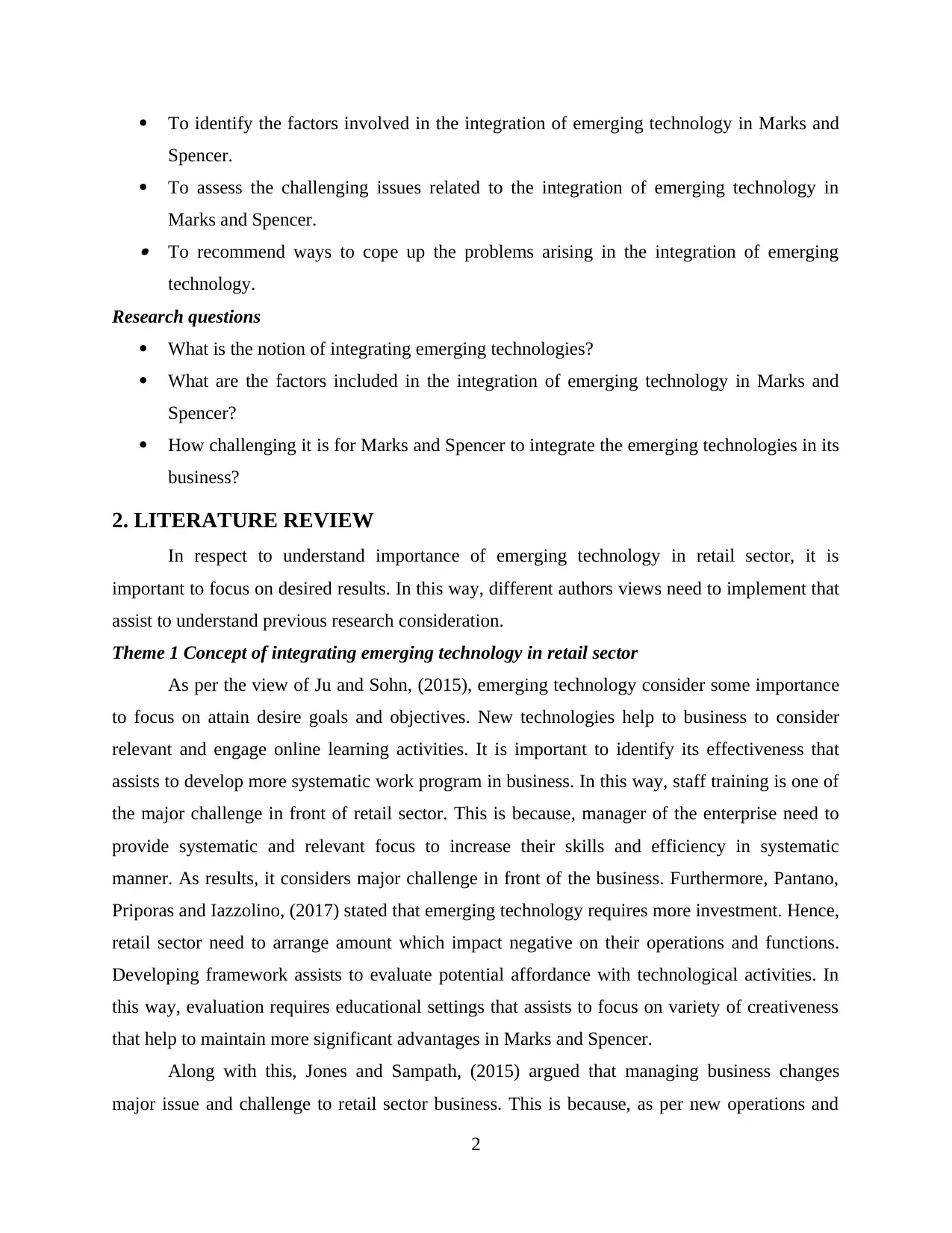
To identify the factors involved in the integration of emerging technology in Marks and
Spencer.
To assess the challenging issues related to the integration of emerging technology in
Marks and Spencer. To recommend ways to cope up the problems arising in the integration of emerging
technology.
Research questions
What is the notion of integrating emerging technologies?
What are the factors included in the integration of emerging technology in Marks and
Spencer?
How challenging it is for Marks and Spencer to integrate the emerging technologies in its
business?
2. LITERATURE REVIEW
In respect to understand importance of emerging technology in retail sector, it is
important to focus on desired results. In this way, different authors views need to implement that
assist to understand previous research consideration.
Theme 1 Concept of integrating emerging technology in retail sector
As per the view of Ju and Sohn, (2015), emerging technology consider some importance
to focus on attain desire goals and objectives. New technologies help to business to consider
relevant and engage online learning activities. It is important to identify its effectiveness that
assists to develop more systematic work program in business. In this way, staff training is one of
the major challenge in front of retail sector. This is because, manager of the enterprise need to
provide systematic and relevant focus to increase their skills and efficiency in systematic
manner. As results, it considers major challenge in front of the business. Furthermore, Pantano,
Priporas and Iazzolino, (2017) stated that emerging technology requires more investment. Hence,
retail sector need to arrange amount which impact negative on their operations and functions.
Developing framework assists to evaluate potential affordance with technological activities. In
this way, evaluation requires educational settings that assists to focus on variety of creativeness
that help to maintain more significant advantages in Marks and Spencer.
Along with this, Jones and Sampath, (2015) argued that managing business changes
major issue and challenge to retail sector business. This is because, as per new operations and
2
Spencer.
To assess the challenging issues related to the integration of emerging technology in
Marks and Spencer. To recommend ways to cope up the problems arising in the integration of emerging
technology.
Research questions
What is the notion of integrating emerging technologies?
What are the factors included in the integration of emerging technology in Marks and
Spencer?
How challenging it is for Marks and Spencer to integrate the emerging technologies in its
business?
2. LITERATURE REVIEW
In respect to understand importance of emerging technology in retail sector, it is
important to focus on desired results. In this way, different authors views need to implement that
assist to understand previous research consideration.
Theme 1 Concept of integrating emerging technology in retail sector
As per the view of Ju and Sohn, (2015), emerging technology consider some importance
to focus on attain desire goals and objectives. New technologies help to business to consider
relevant and engage online learning activities. It is important to identify its effectiveness that
assists to develop more systematic work program in business. In this way, staff training is one of
the major challenge in front of retail sector. This is because, manager of the enterprise need to
provide systematic and relevant focus to increase their skills and efficiency in systematic
manner. As results, it considers major challenge in front of the business. Furthermore, Pantano,
Priporas and Iazzolino, (2017) stated that emerging technology requires more investment. Hence,
retail sector need to arrange amount which impact negative on their operations and functions.
Developing framework assists to evaluate potential affordance with technological activities. In
this way, evaluation requires educational settings that assists to focus on variety of creativeness
that help to maintain more significant advantages in Marks and Spencer.
Along with this, Jones and Sampath, (2015) argued that managing business changes
major issue and challenge to retail sector business. This is because, as per new operations and
2
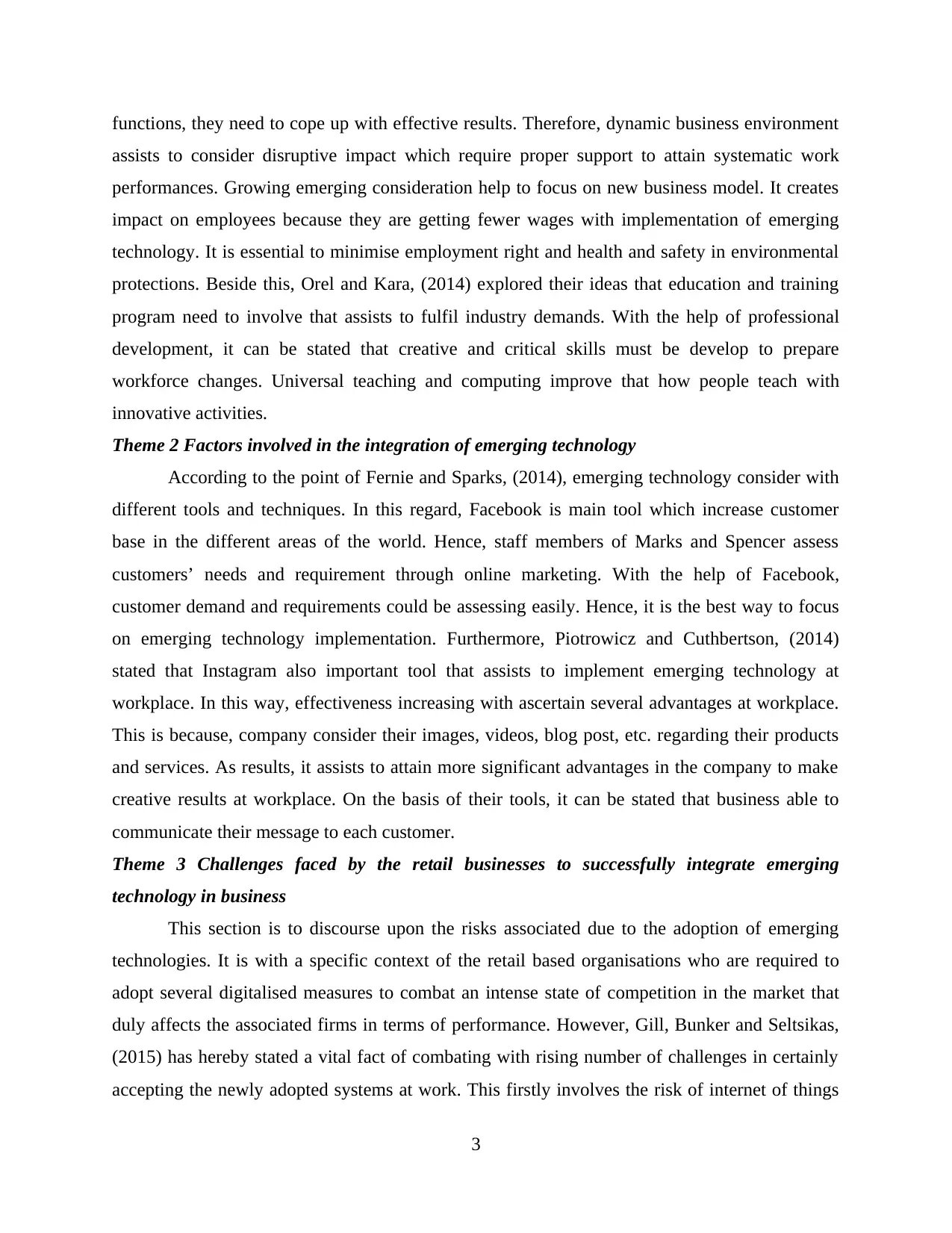
functions, they need to cope up with effective results. Therefore, dynamic business environment
assists to consider disruptive impact which require proper support to attain systematic work
performances. Growing emerging consideration help to focus on new business model. It creates
impact on employees because they are getting fewer wages with implementation of emerging
technology. It is essential to minimise employment right and health and safety in environmental
protections. Beside this, Orel and Kara, (2014) explored their ideas that education and training
program need to involve that assists to fulfil industry demands. With the help of professional
development, it can be stated that creative and critical skills must be develop to prepare
workforce changes. Universal teaching and computing improve that how people teach with
innovative activities.
Theme 2 Factors involved in the integration of emerging technology
According to the point of Fernie and Sparks, (2014), emerging technology consider with
different tools and techniques. In this regard, Facebook is main tool which increase customer
base in the different areas of the world. Hence, staff members of Marks and Spencer assess
customers’ needs and requirement through online marketing. With the help of Facebook,
customer demand and requirements could be assessing easily. Hence, it is the best way to focus
on emerging technology implementation. Furthermore, Piotrowicz and Cuthbertson, (2014)
stated that Instagram also important tool that assists to implement emerging technology at
workplace. In this way, effectiveness increasing with ascertain several advantages at workplace.
This is because, company consider their images, videos, blog post, etc. regarding their products
and services. As results, it assists to attain more significant advantages in the company to make
creative results at workplace. On the basis of their tools, it can be stated that business able to
communicate their message to each customer.
Theme 3 Challenges faced by the retail businesses to successfully integrate emerging
technology in business
This section is to discourse upon the risks associated due to the adoption of emerging
technologies. It is with a specific context of the retail based organisations who are required to
adopt several digitalised measures to combat an intense state of competition in the market that
duly affects the associated firms in terms of performance. However, Gill, Bunker and Seltsikas,
(2015) has hereby stated a vital fact of combating with rising number of challenges in certainly
accepting the newly adopted systems at work. This firstly involves the risk of internet of things
3
assists to consider disruptive impact which require proper support to attain systematic work
performances. Growing emerging consideration help to focus on new business model. It creates
impact on employees because they are getting fewer wages with implementation of emerging
technology. It is essential to minimise employment right and health and safety in environmental
protections. Beside this, Orel and Kara, (2014) explored their ideas that education and training
program need to involve that assists to fulfil industry demands. With the help of professional
development, it can be stated that creative and critical skills must be develop to prepare
workforce changes. Universal teaching and computing improve that how people teach with
innovative activities.
Theme 2 Factors involved in the integration of emerging technology
According to the point of Fernie and Sparks, (2014), emerging technology consider with
different tools and techniques. In this regard, Facebook is main tool which increase customer
base in the different areas of the world. Hence, staff members of Marks and Spencer assess
customers’ needs and requirement through online marketing. With the help of Facebook,
customer demand and requirements could be assessing easily. Hence, it is the best way to focus
on emerging technology implementation. Furthermore, Piotrowicz and Cuthbertson, (2014)
stated that Instagram also important tool that assists to implement emerging technology at
workplace. In this way, effectiveness increasing with ascertain several advantages at workplace.
This is because, company consider their images, videos, blog post, etc. regarding their products
and services. As results, it assists to attain more significant advantages in the company to make
creative results at workplace. On the basis of their tools, it can be stated that business able to
communicate their message to each customer.
Theme 3 Challenges faced by the retail businesses to successfully integrate emerging
technology in business
This section is to discourse upon the risks associated due to the adoption of emerging
technologies. It is with a specific context of the retail based organisations who are required to
adopt several digitalised measures to combat an intense state of competition in the market that
duly affects the associated firms in terms of performance. However, Gill, Bunker and Seltsikas,
(2015) has hereby stated a vital fact of combating with rising number of challenges in certainly
accepting the newly adopted systems at work. This firstly involves the risk of internet of things
3
⊘ This is a preview!⊘
Do you want full access?
Subscribe today to unlock all pages.

Trusted by 1+ million students worldwide
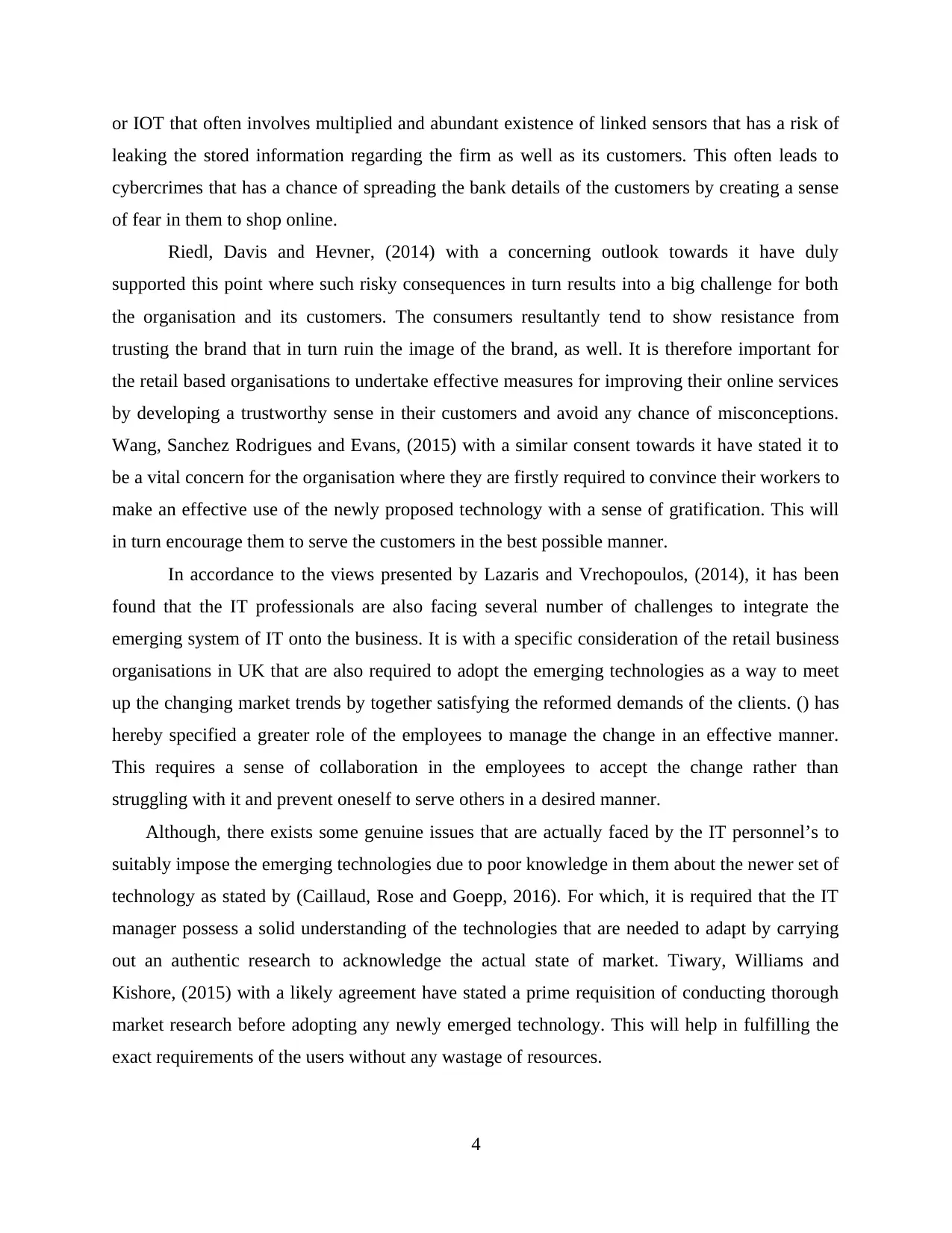
or IOT that often involves multiplied and abundant existence of linked sensors that has a risk of
leaking the stored information regarding the firm as well as its customers. This often leads to
cybercrimes that has a chance of spreading the bank details of the customers by creating a sense
of fear in them to shop online.
Riedl, Davis and Hevner, (2014) with a concerning outlook towards it have duly
supported this point where such risky consequences in turn results into a big challenge for both
the organisation and its customers. The consumers resultantly tend to show resistance from
trusting the brand that in turn ruin the image of the brand, as well. It is therefore important for
the retail based organisations to undertake effective measures for improving their online services
by developing a trustworthy sense in their customers and avoid any chance of misconceptions.
Wang, Sanchez Rodrigues and Evans, (2015) with a similar consent towards it have stated it to
be a vital concern for the organisation where they are firstly required to convince their workers to
make an effective use of the newly proposed technology with a sense of gratification. This will
in turn encourage them to serve the customers in the best possible manner.
In accordance to the views presented by Lazaris and Vrechopoulos, (2014), it has been
found that the IT professionals are also facing several number of challenges to integrate the
emerging system of IT onto the business. It is with a specific consideration of the retail business
organisations in UK that are also required to adopt the emerging technologies as a way to meet
up the changing market trends by together satisfying the reformed demands of the clients. () has
hereby specified a greater role of the employees to manage the change in an effective manner.
This requires a sense of collaboration in the employees to accept the change rather than
struggling with it and prevent oneself to serve others in a desired manner.
Although, there exists some genuine issues that are actually faced by the IT personnel’s to
suitably impose the emerging technologies due to poor knowledge in them about the newer set of
technology as stated by (Caillaud, Rose and Goepp, 2016). For which, it is required that the IT
manager possess a solid understanding of the technologies that are needed to adapt by carrying
out an authentic research to acknowledge the actual state of market. Tiwary, Williams and
Kishore, (2015) with a likely agreement have stated a prime requisition of conducting thorough
market research before adopting any newly emerged technology. This will help in fulfilling the
exact requirements of the users without any wastage of resources.
4
leaking the stored information regarding the firm as well as its customers. This often leads to
cybercrimes that has a chance of spreading the bank details of the customers by creating a sense
of fear in them to shop online.
Riedl, Davis and Hevner, (2014) with a concerning outlook towards it have duly
supported this point where such risky consequences in turn results into a big challenge for both
the organisation and its customers. The consumers resultantly tend to show resistance from
trusting the brand that in turn ruin the image of the brand, as well. It is therefore important for
the retail based organisations to undertake effective measures for improving their online services
by developing a trustworthy sense in their customers and avoid any chance of misconceptions.
Wang, Sanchez Rodrigues and Evans, (2015) with a similar consent towards it have stated it to
be a vital concern for the organisation where they are firstly required to convince their workers to
make an effective use of the newly proposed technology with a sense of gratification. This will
in turn encourage them to serve the customers in the best possible manner.
In accordance to the views presented by Lazaris and Vrechopoulos, (2014), it has been
found that the IT professionals are also facing several number of challenges to integrate the
emerging system of IT onto the business. It is with a specific consideration of the retail business
organisations in UK that are also required to adopt the emerging technologies as a way to meet
up the changing market trends by together satisfying the reformed demands of the clients. () has
hereby specified a greater role of the employees to manage the change in an effective manner.
This requires a sense of collaboration in the employees to accept the change rather than
struggling with it and prevent oneself to serve others in a desired manner.
Although, there exists some genuine issues that are actually faced by the IT personnel’s to
suitably impose the emerging technologies due to poor knowledge in them about the newer set of
technology as stated by (Caillaud, Rose and Goepp, 2016). For which, it is required that the IT
manager possess a solid understanding of the technologies that are needed to adapt by carrying
out an authentic research to acknowledge the actual state of market. Tiwary, Williams and
Kishore, (2015) with a likely agreement have stated a prime requisition of conducting thorough
market research before adopting any newly emerged technology. This will help in fulfilling the
exact requirements of the users without any wastage of resources.
4
Paraphrase This Document
Need a fresh take? Get an instant paraphrase of this document with our AI Paraphraser
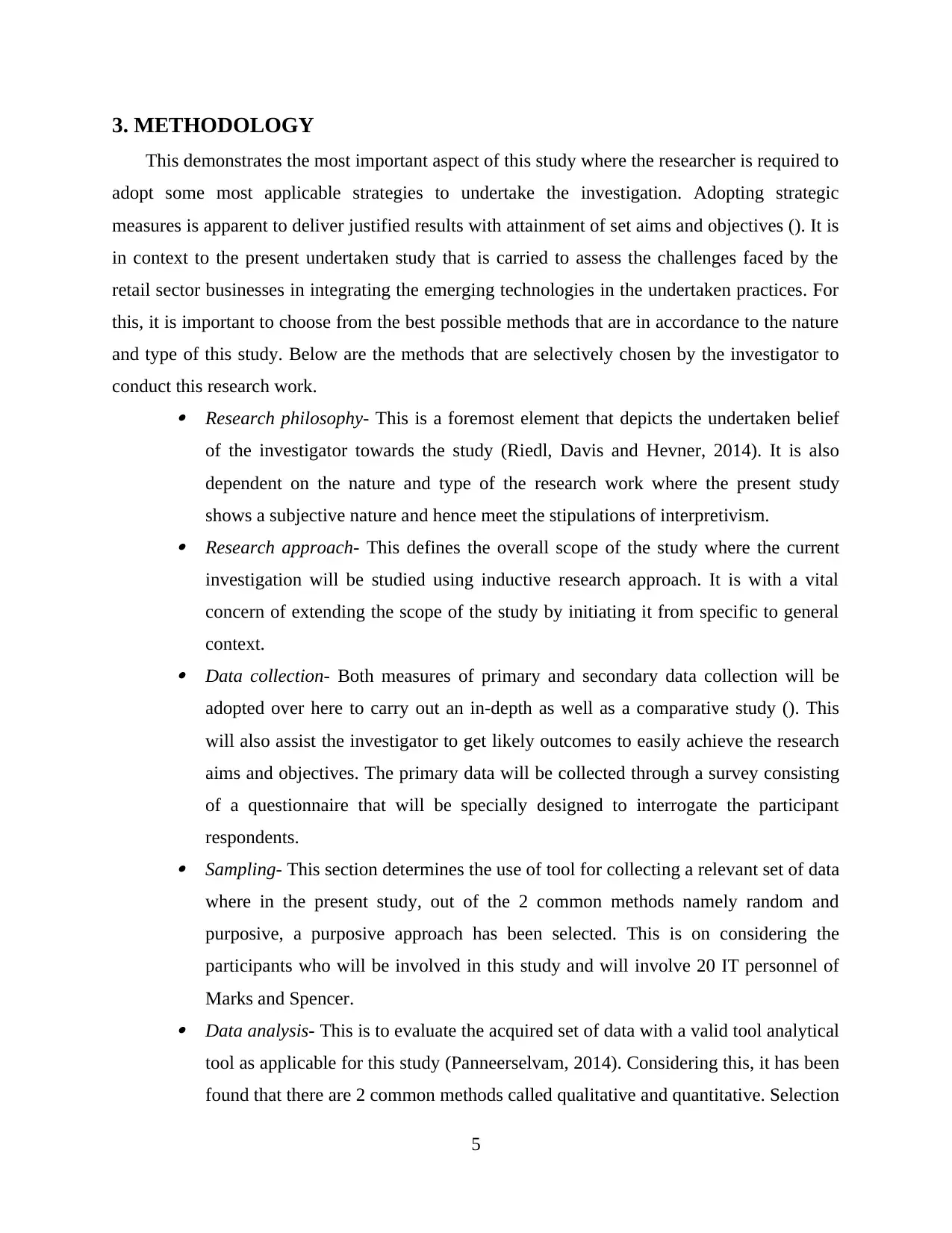
3. METHODOLOGY
This demonstrates the most important aspect of this study where the researcher is required to
adopt some most applicable strategies to undertake the investigation. Adopting strategic
measures is apparent to deliver justified results with attainment of set aims and objectives (). It is
in context to the present undertaken study that is carried to assess the challenges faced by the
retail sector businesses in integrating the emerging technologies in the undertaken practices. For
this, it is important to choose from the best possible methods that are in accordance to the nature
and type of this study. Below are the methods that are selectively chosen by the investigator to
conduct this research work.
Research philosophy- This is a foremost element that depicts the undertaken belief
of the investigator towards the study (Riedl, Davis and Hevner, 2014). It is also
dependent on the nature and type of the research work where the present study
shows a subjective nature and hence meet the stipulations of interpretivism.
Research approach- This defines the overall scope of the study where the current
investigation will be studied using inductive research approach. It is with a vital
concern of extending the scope of the study by initiating it from specific to general
context.
Data collection- Both measures of primary and secondary data collection will be
adopted over here to carry out an in-depth as well as a comparative study (). This
will also assist the investigator to get likely outcomes to easily achieve the research
aims and objectives. The primary data will be collected through a survey consisting
of a questionnaire that will be specially designed to interrogate the participant
respondents.
Sampling- This section determines the use of tool for collecting a relevant set of data
where in the present study, out of the 2 common methods namely random and
purposive, a purposive approach has been selected. This is on considering the
participants who will be involved in this study and will involve 20 IT personnel of
Marks and Spencer.
Data analysis- This is to evaluate the acquired set of data with a valid tool analytical
tool as applicable for this study (Panneerselvam, 2014). Considering this, it has been
found that there are 2 common methods called qualitative and quantitative. Selection
5
This demonstrates the most important aspect of this study where the researcher is required to
adopt some most applicable strategies to undertake the investigation. Adopting strategic
measures is apparent to deliver justified results with attainment of set aims and objectives (). It is
in context to the present undertaken study that is carried to assess the challenges faced by the
retail sector businesses in integrating the emerging technologies in the undertaken practices. For
this, it is important to choose from the best possible methods that are in accordance to the nature
and type of this study. Below are the methods that are selectively chosen by the investigator to
conduct this research work.
Research philosophy- This is a foremost element that depicts the undertaken belief
of the investigator towards the study (Riedl, Davis and Hevner, 2014). It is also
dependent on the nature and type of the research work where the present study
shows a subjective nature and hence meet the stipulations of interpretivism.
Research approach- This defines the overall scope of the study where the current
investigation will be studied using inductive research approach. It is with a vital
concern of extending the scope of the study by initiating it from specific to general
context.
Data collection- Both measures of primary and secondary data collection will be
adopted over here to carry out an in-depth as well as a comparative study (). This
will also assist the investigator to get likely outcomes to easily achieve the research
aims and objectives. The primary data will be collected through a survey consisting
of a questionnaire that will be specially designed to interrogate the participant
respondents.
Sampling- This section determines the use of tool for collecting a relevant set of data
where in the present study, out of the 2 common methods namely random and
purposive, a purposive approach has been selected. This is on considering the
participants who will be involved in this study and will involve 20 IT personnel of
Marks and Spencer.
Data analysis- This is to evaluate the acquired set of data with a valid tool analytical
tool as applicable for this study (Panneerselvam, 2014). Considering this, it has been
found that there are 2 common methods called qualitative and quantitative. Selection
5
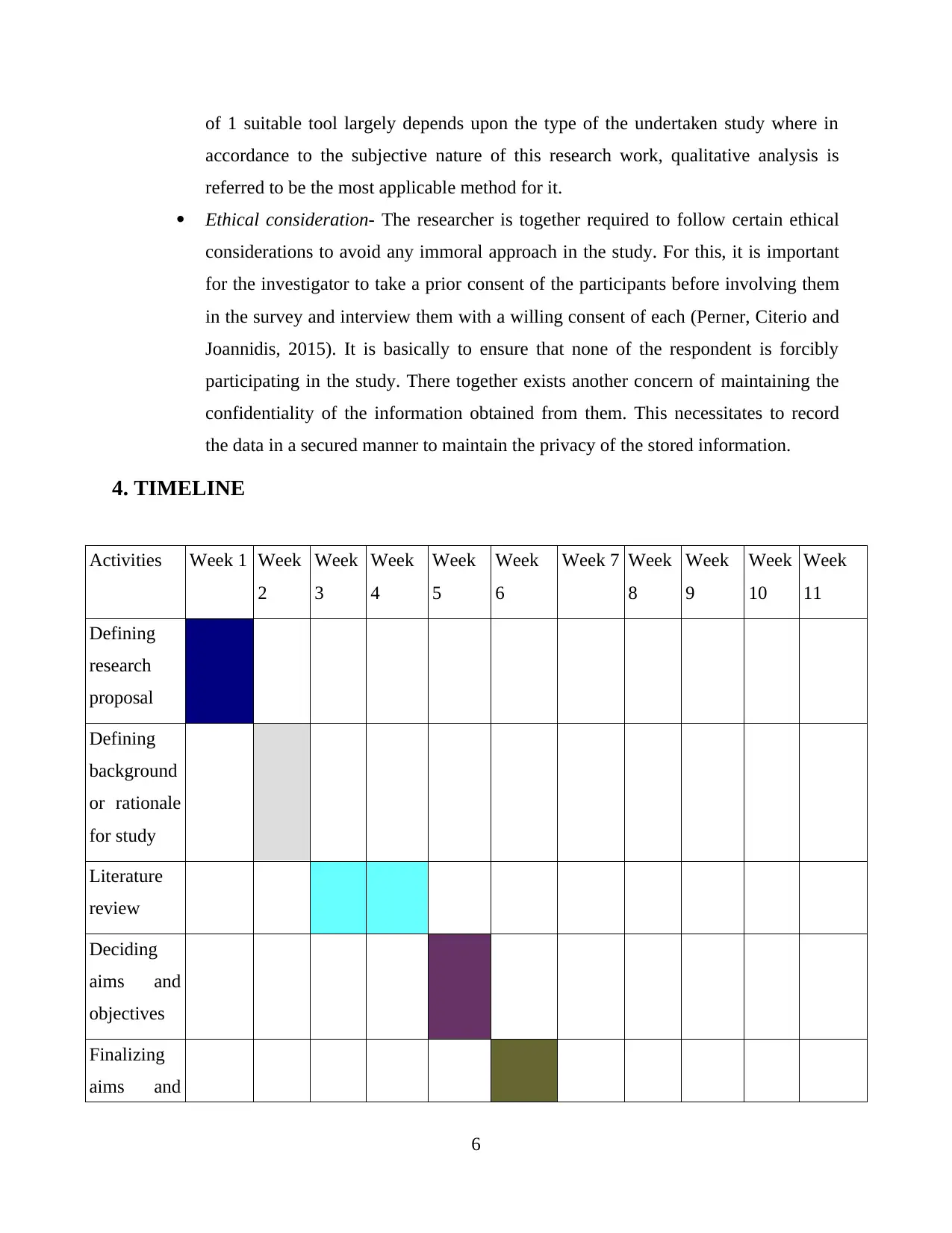
of 1 suitable tool largely depends upon the type of the undertaken study where in
accordance to the subjective nature of this research work, qualitative analysis is
referred to be the most applicable method for it.
Ethical consideration- The researcher is together required to follow certain ethical
considerations to avoid any immoral approach in the study. For this, it is important
for the investigator to take a prior consent of the participants before involving them
in the survey and interview them with a willing consent of each (Perner, Citerio and
Joannidis, 2015). It is basically to ensure that none of the respondent is forcibly
participating in the study. There together exists another concern of maintaining the
confidentiality of the information obtained from them. This necessitates to record
the data in a secured manner to maintain the privacy of the stored information.
4. TIMELINE
Activities Week 1 Week
2
Week
3
Week
4
Week
5
Week
6
Week 7 Week
8
Week
9
Week
10
Week
11
Defining
research
proposal
Defining
background
or rationale
for study
Literature
review
Deciding
aims and
objectives
Finalizing
aims and
6
accordance to the subjective nature of this research work, qualitative analysis is
referred to be the most applicable method for it.
Ethical consideration- The researcher is together required to follow certain ethical
considerations to avoid any immoral approach in the study. For this, it is important
for the investigator to take a prior consent of the participants before involving them
in the survey and interview them with a willing consent of each (Perner, Citerio and
Joannidis, 2015). It is basically to ensure that none of the respondent is forcibly
participating in the study. There together exists another concern of maintaining the
confidentiality of the information obtained from them. This necessitates to record
the data in a secured manner to maintain the privacy of the stored information.
4. TIMELINE
Activities Week 1 Week
2
Week
3
Week
4
Week
5
Week
6
Week 7 Week
8
Week
9
Week
10
Week
11
Defining
research
proposal
Defining
background
or rationale
for study
Literature
review
Deciding
aims and
objectives
Finalizing
aims and
6
⊘ This is a preview!⊘
Do you want full access?
Subscribe today to unlock all pages.

Trusted by 1+ million students worldwide
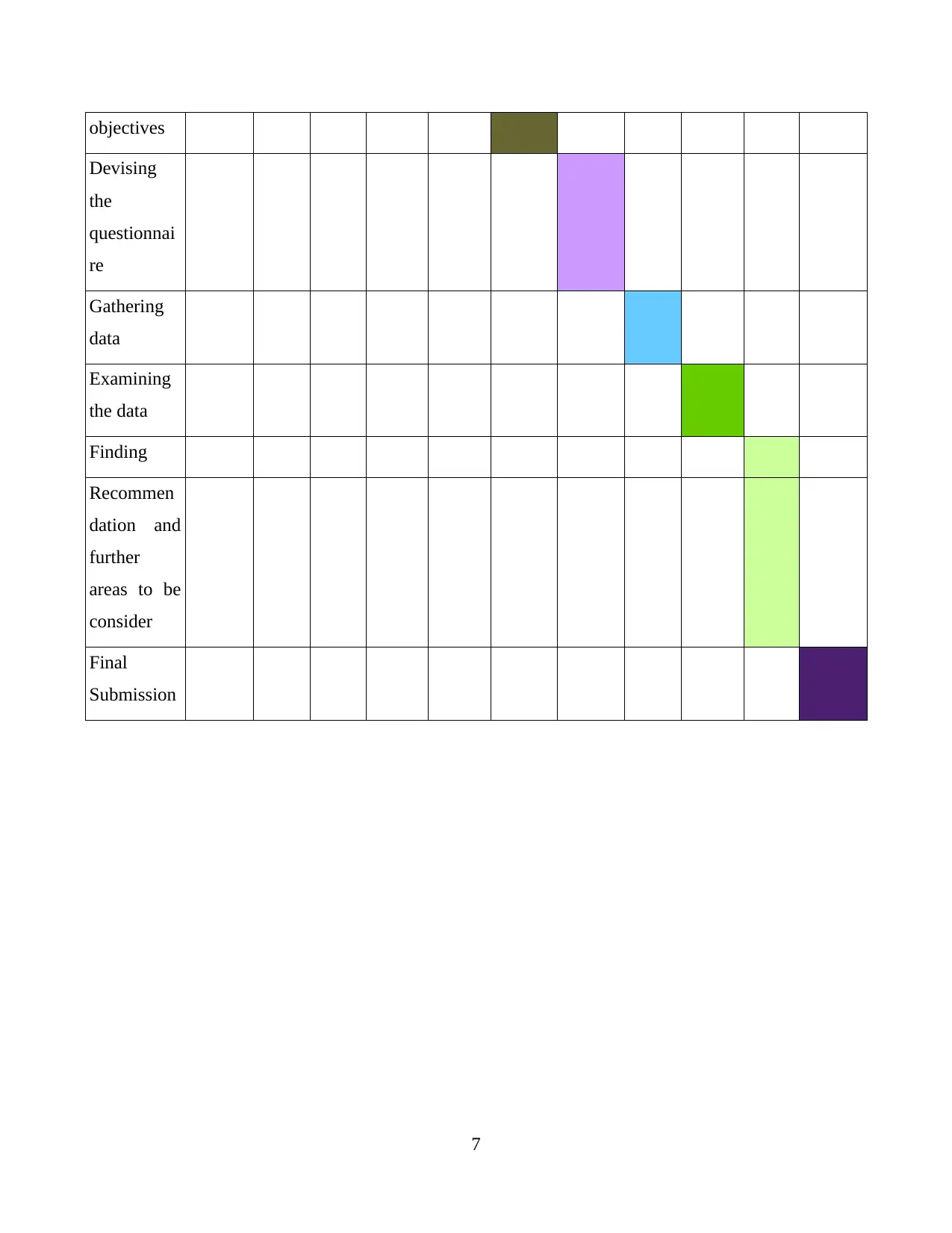
objectives
Devising
the
questionnai
re
Gathering
data
Examining
the data
Finding
Recommen
dation and
further
areas to be
consider
Final
Submission
7
Devising
the
questionnai
re
Gathering
data
Examining
the data
Finding
Recommen
dation and
further
areas to be
consider
Final
Submission
7
Paraphrase This Document
Need a fresh take? Get an instant paraphrase of this document with our AI Paraphraser
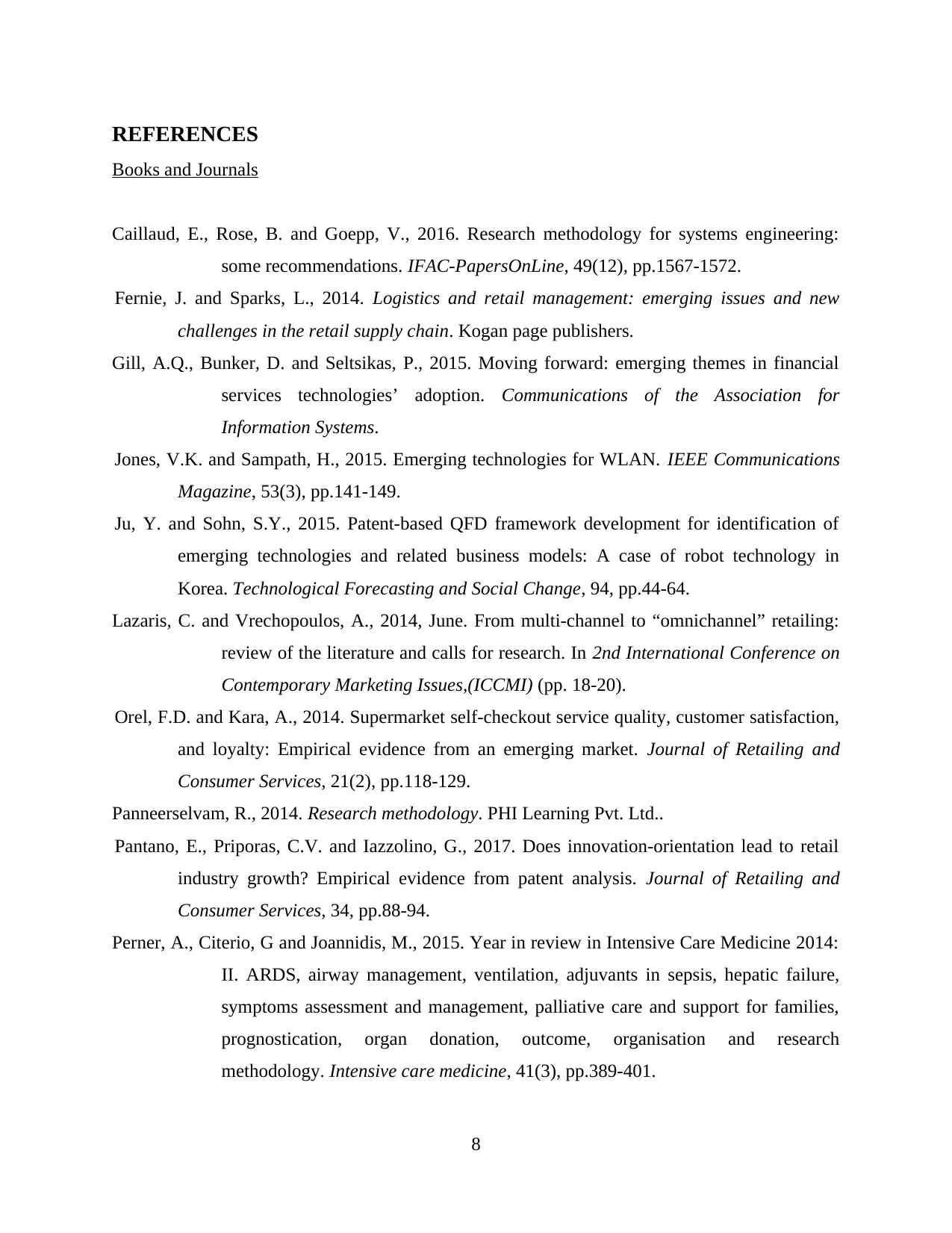
REFERENCES
Books and Journals
Caillaud, E., Rose, B. and Goepp, V., 2016. Research methodology for systems engineering:
some recommendations. IFAC-PapersOnLine, 49(12), pp.1567-1572.
Fernie, J. and Sparks, L., 2014. Logistics and retail management: emerging issues and new
challenges in the retail supply chain. Kogan page publishers.
Gill, A.Q., Bunker, D. and Seltsikas, P., 2015. Moving forward: emerging themes in financial
services technologies’ adoption. Communications of the Association for
Information Systems.
Jones, V.K. and Sampath, H., 2015. Emerging technologies for WLAN. IEEE Communications
Magazine, 53(3), pp.141-149.
Ju, Y. and Sohn, S.Y., 2015. Patent-based QFD framework development for identification of
emerging technologies and related business models: A case of robot technology in
Korea. Technological Forecasting and Social Change, 94, pp.44-64.
Lazaris, C. and Vrechopoulos, A., 2014, June. From multi-channel to “omnichannel” retailing:
review of the literature and calls for research. In 2nd International Conference on
Contemporary Marketing Issues,(ICCMI) (pp. 18-20).
Orel, F.D. and Kara, A., 2014. Supermarket self-checkout service quality, customer satisfaction,
and loyalty: Empirical evidence from an emerging market. Journal of Retailing and
Consumer Services, 21(2), pp.118-129.
Panneerselvam, R., 2014. Research methodology. PHI Learning Pvt. Ltd..
Pantano, E., Priporas, C.V. and Iazzolino, G., 2017. Does innovation-orientation lead to retail
industry growth? Empirical evidence from patent analysis. Journal of Retailing and
Consumer Services, 34, pp.88-94.
Perner, A., Citerio, G and Joannidis, M., 2015. Year in review in Intensive Care Medicine 2014:
II. ARDS, airway management, ventilation, adjuvants in sepsis, hepatic failure,
symptoms assessment and management, palliative care and support for families,
prognostication, organ donation, outcome, organisation and research
methodology. Intensive care medicine, 41(3), pp.389-401.
8
Books and Journals
Caillaud, E., Rose, B. and Goepp, V., 2016. Research methodology for systems engineering:
some recommendations. IFAC-PapersOnLine, 49(12), pp.1567-1572.
Fernie, J. and Sparks, L., 2014. Logistics and retail management: emerging issues and new
challenges in the retail supply chain. Kogan page publishers.
Gill, A.Q., Bunker, D. and Seltsikas, P., 2015. Moving forward: emerging themes in financial
services technologies’ adoption. Communications of the Association for
Information Systems.
Jones, V.K. and Sampath, H., 2015. Emerging technologies for WLAN. IEEE Communications
Magazine, 53(3), pp.141-149.
Ju, Y. and Sohn, S.Y., 2015. Patent-based QFD framework development for identification of
emerging technologies and related business models: A case of robot technology in
Korea. Technological Forecasting and Social Change, 94, pp.44-64.
Lazaris, C. and Vrechopoulos, A., 2014, June. From multi-channel to “omnichannel” retailing:
review of the literature and calls for research. In 2nd International Conference on
Contemporary Marketing Issues,(ICCMI) (pp. 18-20).
Orel, F.D. and Kara, A., 2014. Supermarket self-checkout service quality, customer satisfaction,
and loyalty: Empirical evidence from an emerging market. Journal of Retailing and
Consumer Services, 21(2), pp.118-129.
Panneerselvam, R., 2014. Research methodology. PHI Learning Pvt. Ltd..
Pantano, E., Priporas, C.V. and Iazzolino, G., 2017. Does innovation-orientation lead to retail
industry growth? Empirical evidence from patent analysis. Journal of Retailing and
Consumer Services, 34, pp.88-94.
Perner, A., Citerio, G and Joannidis, M., 2015. Year in review in Intensive Care Medicine 2014:
II. ARDS, airway management, ventilation, adjuvants in sepsis, hepatic failure,
symptoms assessment and management, palliative care and support for families,
prognostication, organ donation, outcome, organisation and research
methodology. Intensive care medicine, 41(3), pp.389-401.
8
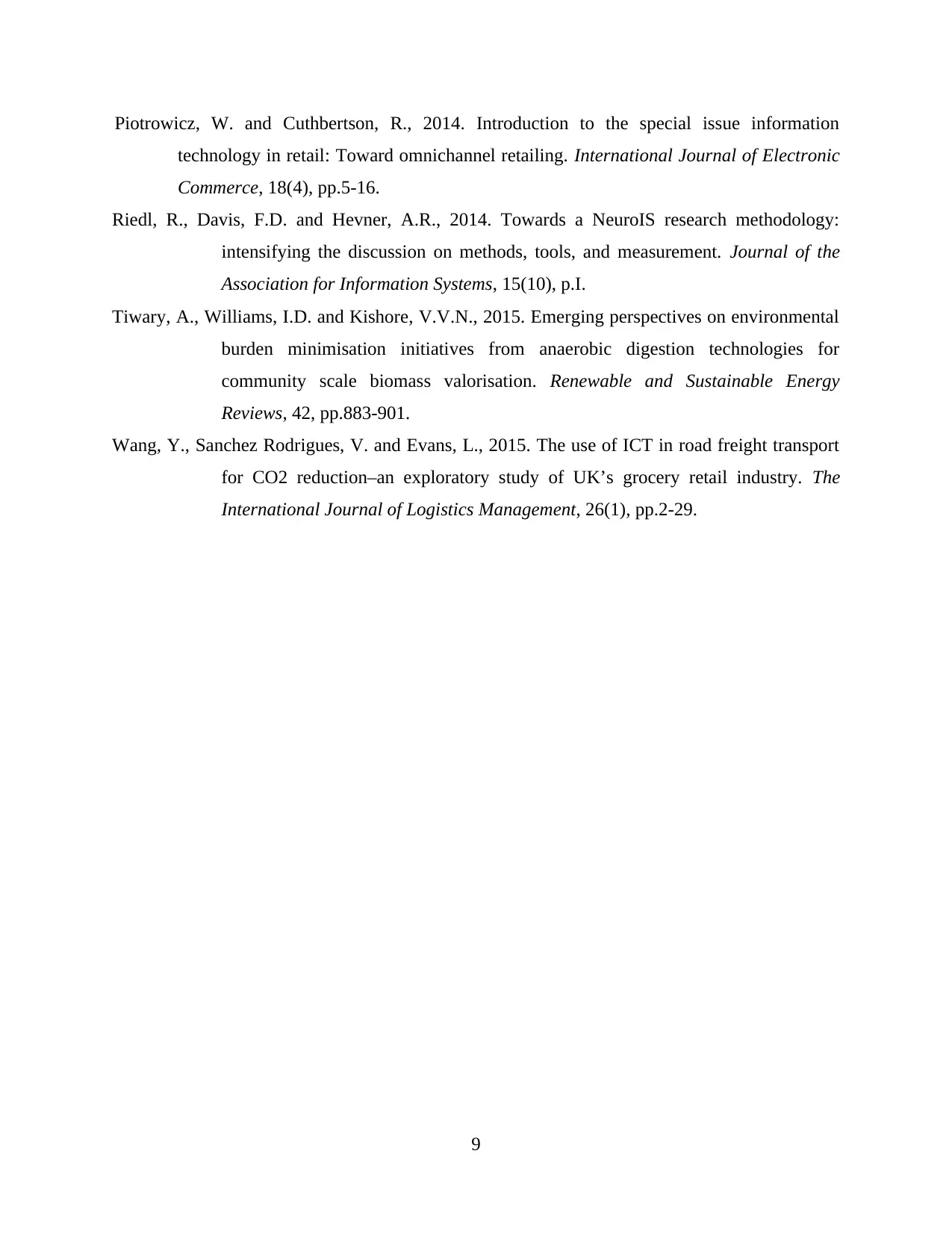
Piotrowicz, W. and Cuthbertson, R., 2014. Introduction to the special issue information
technology in retail: Toward omnichannel retailing. International Journal of Electronic
Commerce, 18(4), pp.5-16.
Riedl, R., Davis, F.D. and Hevner, A.R., 2014. Towards a NeuroIS research methodology:
intensifying the discussion on methods, tools, and measurement. Journal of the
Association for Information Systems, 15(10), p.I.
Tiwary, A., Williams, I.D. and Kishore, V.V.N., 2015. Emerging perspectives on environmental
burden minimisation initiatives from anaerobic digestion technologies for
community scale biomass valorisation. Renewable and Sustainable Energy
Reviews, 42, pp.883-901.
Wang, Y., Sanchez Rodrigues, V. and Evans, L., 2015. The use of ICT in road freight transport
for CO2 reduction–an exploratory study of UK’s grocery retail industry. The
International Journal of Logistics Management, 26(1), pp.2-29.
9
technology in retail: Toward omnichannel retailing. International Journal of Electronic
Commerce, 18(4), pp.5-16.
Riedl, R., Davis, F.D. and Hevner, A.R., 2014. Towards a NeuroIS research methodology:
intensifying the discussion on methods, tools, and measurement. Journal of the
Association for Information Systems, 15(10), p.I.
Tiwary, A., Williams, I.D. and Kishore, V.V.N., 2015. Emerging perspectives on environmental
burden minimisation initiatives from anaerobic digestion technologies for
community scale biomass valorisation. Renewable and Sustainable Energy
Reviews, 42, pp.883-901.
Wang, Y., Sanchez Rodrigues, V. and Evans, L., 2015. The use of ICT in road freight transport
for CO2 reduction–an exploratory study of UK’s grocery retail industry. The
International Journal of Logistics Management, 26(1), pp.2-29.
9
⊘ This is a preview!⊘
Do you want full access?
Subscribe today to unlock all pages.

Trusted by 1+ million students worldwide
1 out of 12
Related Documents
Your All-in-One AI-Powered Toolkit for Academic Success.
+13062052269
info@desklib.com
Available 24*7 on WhatsApp / Email
![[object Object]](/_next/static/media/star-bottom.7253800d.svg)
Unlock your academic potential
Copyright © 2020–2025 A2Z Services. All Rights Reserved. Developed and managed by ZUCOL.





